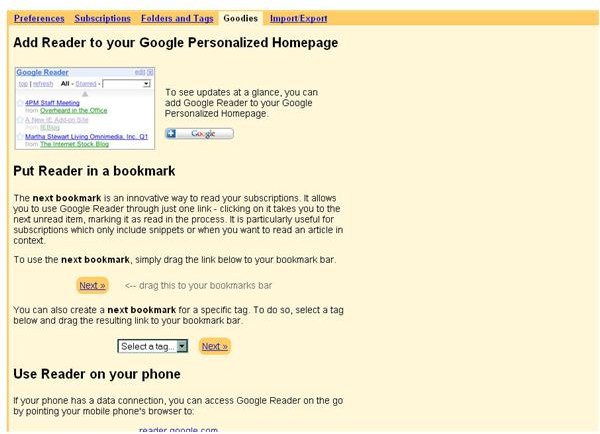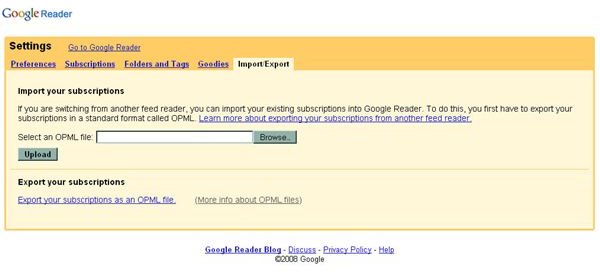How to Use Google Reader - ARCHIVED
Editor’s Note: Google Reader is being shut down on July 1, 2013. Users are encouraged to use Google Takeout in order to transfer their accounts to other RSS feeds. This article was orginally published in 2008 and has been archived but left up for informational purposes.
Google Reader is one of the most efficient, clean-looking RSS feed readers online. If you already have a Google account, you’ve already done most of the work involved in setting up your own Google Reader account. If you don’t have a Google account already, setting one up is simple. If you don’t use Gmail, fear not. You can create a Google account with your current email address. If you need step-by-step directions for setting up your Gmail account read How to Set up a Gmail Account.
Go to Google’s Create an Account page. Fill out the form and submit. In a few seconds, check your email and click on the confirmation link. Presto! You have a Google account. Your sign in name will be your email address.
Google Reader Settings
When you sign into your account page, the first link at the top left will be Google Reader. Click the link next to it that says Settings.
From the settings page you can customize Google Reader to your liking. From the Settings panel you can click on one of five tabs: Preferences, Subscriptions, Folders and Tags, Goodies, Import/Export. If you’re new to using a feed reader, I suggest sticking with the default options. As you use Google Reader, you’ll learn what you like and what you don’t, then you can start changing settings to the way you want them.
Preferences
This tab covers the basic options. Select your language. Set Google Reader Home Page to show all items or only certain items, like ones

you’ve starred. Select or deselect the Scroll Tracking option to choose whether the reader marks items as read while you scroll past them or not. Choose whether to always start showing navigation pane. You can also choose to confirm when marking all your topics as read, and to show followed blogs from Blogger.
Folders and Tags
The Subscriptions tab and Folders and Tags will be empty right now. Once you’ve added some feeds, you can use these tabs to

organize or edit your feeds. Folders and Tags also allows you to choose privacy settings for individual tags. This is setting is really useful when you have lots of feeds for different purposes.
Goodies
From this tab you can add Google Reader to your Google Homepage. It also let’s you drag and drop Google Reader to a bookmark.

You can use Next Bookmark by clicking a single link. Each time you click the link, you will taken to your next unread item. You can add Google Reader to your cell phone from this tab. There’s also a link to drag to your toolbar that will add a bookmark to your toolbar. When viewing a web page, just click the link to view it in Google Reader.
Import/Export
For more advanced users, you can import your feeds from another reader. Just export them in OPML format and save to your computer.

Sign into Google Reader, click settings, Import/Export. Click the Browse button, find your OPML file, and then upload it. You can also export Google Reader feeds from this tab if you are switching to another reader.
Add Feeds
From the settings panel, click Go to Google Reader. From this page, you can click Take a Tour, or

watch a video a Google engineer, Chris Wetherell, tell all about Google Reader. If you’re new to feed readers, both those options are worthwhile. For those who are familiar with feed readers, it’s really unnecessary to bother with the tour and video. When you’re ready, click “Get started by adding subscriptions.” Google has some pre-selected bundles of feeds in a few different categories. Newbies should select one of these to play around with Google Reader a little bit. This page also allows new users to quickly add feeds from Flickr, Blogger, del.icio.us, Live Journal, Windows Live Spaces, Xanga, Wordpress.com, and Myspace by typing in a username, selecting a website from the pull down menu, and clicking Subscribe.
If you’ve been following through, step-by-step, then you’re Google Reader account is all set up and ready to use. Whenever you see a little orange RSS link, click it to add to Google Reader.
Note About Privacy
If you have a Gmail account, Google Reader automatically shares all your shared items with all the Google Reader users in your address book. You should manually control this by selecting friends. Click Sharing Settings, on the left sidebar menu. From that page, you can choose whether to share with everyone or just friends. Choose friends by their email address, or remove people from your sharing list completely. If you use Gmail for professional emails or you just want to keep your shared items private from any particular people, I suggest you check out these settings before you start sharing.
This article has been placed in our archives.
This post is part of the series: Google Reader, a Comprehensive Guide
Google Reader is an easy an straightforward feed reader. Learn how to use it, along with tips and tricks to customize Google Reader.
